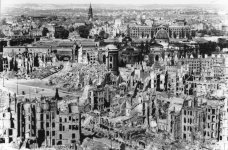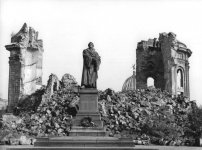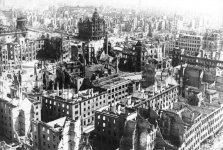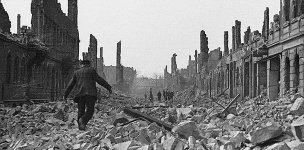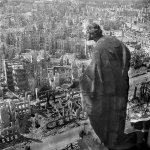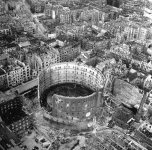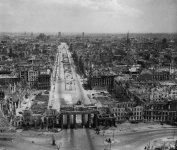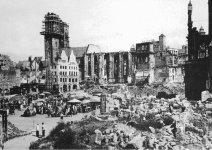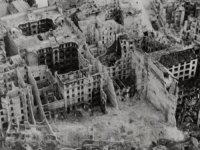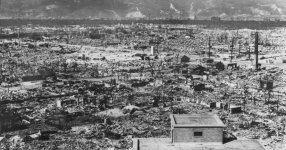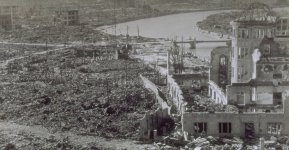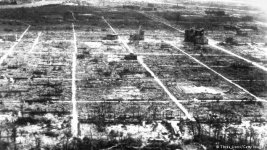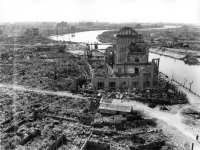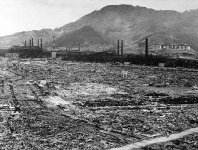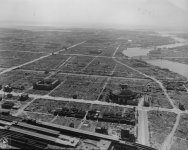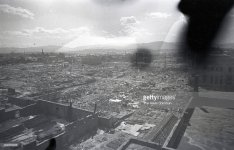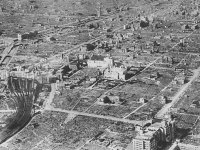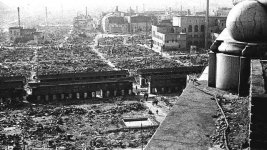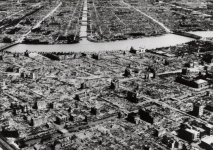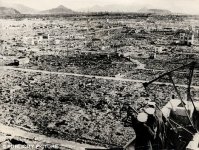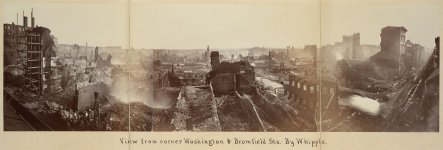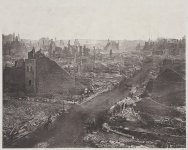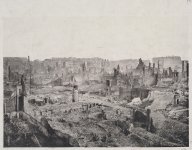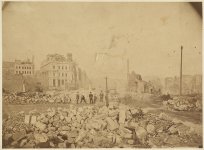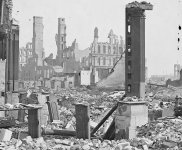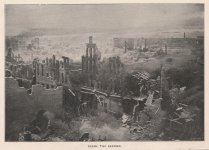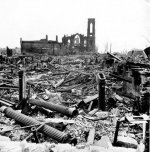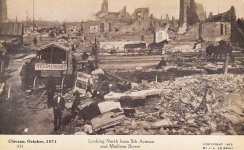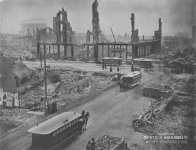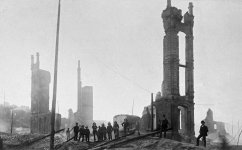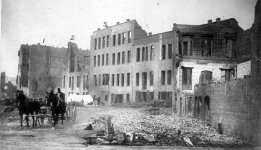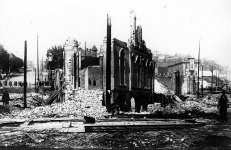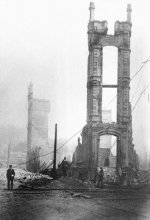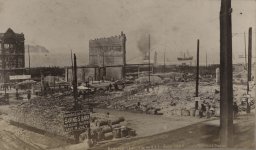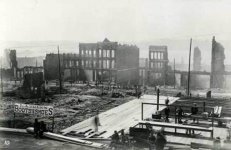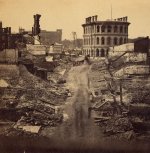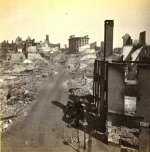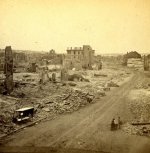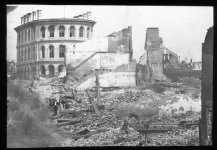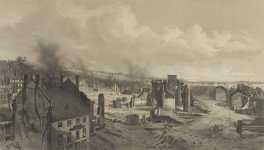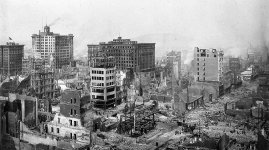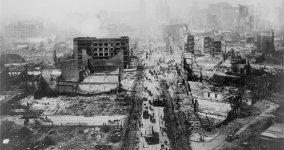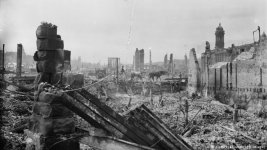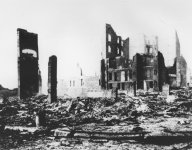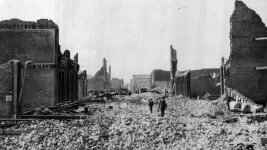I understand how crazy it sounds. How could American cities get destroyed by an unknown weapon in 19th and early 20th centuries? Supposedly the technology was not there. An event of this magnitude would have been reflected in history and memory of generations. After all, Hiroshima and Nagasaki are well documented. Officially there were only two Japanese cities destroyed by nuclear weapons. But how do you know? Because that is the official version, that's how.
Yet, the below seal imprint on clay shows King Nebuchadnezzar II (ruled between 605 – 562 BCE), releasing a large object, which appears similar to modern day atom bomb or nuclear bomb.

Let us look at the German city of Dresden. Specifically at the Bombing of Dresden in World War II. This bombing made history as one of the most heavy conventional bombing operations in the history of the world. Below are some of the details of this event:
Let us inspect those damages from the conventional explosives and the resulting fire storm. We see heavily damaged buildings. Most roofs are gone. If the wall is collapsed we can see individual bricks or wall parts laying on the ground. If the entire building is collapsed, you can see the remnants of this collapsed building where the building once stood. In general the structures are still standing with all the catastrophic damages sustained.
UPDATE NOTE: I was wrong. Even with Dresden things were not straight - What weapon was used to bomb WW2 Dresden?
Below are the damages sustained by Hiroshima and Nagasaki. As we know, the damages were caused by nuclear weapons.
As can be seen in the above photos, the damages are totally different. While Dresden is mostly standing, the nuclear devastation in the photos of Hiroshima and Nagasaki suggests a totally different level of force applied. This is total annihilation. A few building remain somewhat standing. The remainder is crushed to the level of individual bricks. A little more damage and one could say that Hiroshima and Nagasaki just evaporated because of the barbaric force used.
Now let us compare the above where on one side we have conventional type damages to Dresden and Berlin in Germany, and Hiroshima/Nagasaki in Japan on the other, to the below cities of Tokyo, Fukuoka, Yamaguchi, Hamamatsu, Osaka. I picked a few cities. Help yourself via Google [city name] world war bombing. And look at the pictures. They all look similar. And this similarity appears to be closer to Hiroshima and Nagasaki than Dresden or Berlin.
Obviously Wikipedia explains everything by conventional bombing air raids. And while pictures of damages to Osaka, Fukuoka, Yamaguchi, Nagano, Tokyo, Hamamatsu etc., suggest use of "more powerful" weapons similar to nuclear, the official version has to stand. Otherwise we would be getting into the conspiracy theory territory, wouldn't we?
Here we approach the United States territory.
For the full list of Great Fires you can direct your attention to the List of Town and City Fires kindly provided by Wikipedia.The Fires I was looking at, took place between 1870 - 1890. (Additionally posted San Francisco Earthquake/Fire of 1906.) Though the time span for investigation should probably be 1850 - 1910ish. The dates are historical facts provided to us, and supposedly confirmed by documents and other official sources or records. The reality could bring those dates much closer together. The history after all is written by the victors (Winston Churchill). So who knows what they wrote in there...
The Great Boston fire of 1872. Provided facts:
The Great Chicago fire of 1871. Provided facts:
The Great Seattle fire of 1889. Provided facts:
1866 Great fire of Portland, Maine. Provided facts:
1906 San Francisco earthquake. Provided facts:
The above damages sustained by the United States cities appears to fall in between nuclear power level explosives and conventional ones. Sometimes if it walks/quacks like a duck it could be one.
While there are a lot of other cities destroyed by so-called Firestorms, there is one additional thing bringing these cities together. And that is the speed of recovery and their re-building pace. The replacement buildings were not your contemporary plywood and siding structures. The replacement were often built with Victorian and Romanesque styles in mind. Those were masterpieces of constructional and architectural genius. Whether the infrastructure of the 19th Century could support such a pace remains to be seen. We will look at some inconsistencies related to this so-called rebuilding some other day.
And some additional food for thought:
KD: Feel free to leave your comments.
Yet, the below seal imprint on clay shows King Nebuchadnezzar II (ruled between 605 – 562 BCE), releasing a large object, which appears similar to modern day atom bomb or nuclear bomb.
Let us look at the German city of Dresden. Specifically at the Bombing of Dresden in World War II. This bombing made history as one of the most heavy conventional bombing operations in the history of the world. Below are some of the details of this event:
- four raids between 13 and 15 February 1945
- 722 heavy bombers of the British Royal Air Force (RAF)
- 527 heavy bombers of the United States Army Air Forces (USAAF)
- more than 3,900 tons of high-explosive bombs and incendiary devices were dropped on the city of Dresden
- the bombing and the resulting firestorm destroyed over 1,600 acres (6.5 km2) of the city centre. An estimated 22,700 to 25,000 people were killed.
- three more USAAF air raids followed on March 2 and April 17
Let us inspect those damages from the conventional explosives and the resulting fire storm. We see heavily damaged buildings. Most roofs are gone. If the wall is collapsed we can see individual bricks or wall parts laying on the ground. If the entire building is collapsed, you can see the remnants of this collapsed building where the building once stood. In general the structures are still standing with all the catastrophic damages sustained.
UPDATE NOTE: I was wrong. Even with Dresden things were not straight - What weapon was used to bomb WW2 Dresden?
Below are the damages sustained by Hiroshima and Nagasaki. As we know, the damages were caused by nuclear weapons.
As can be seen in the above photos, the damages are totally different. While Dresden is mostly standing, the nuclear devastation in the photos of Hiroshima and Nagasaki suggests a totally different level of force applied. This is total annihilation. A few building remain somewhat standing. The remainder is crushed to the level of individual bricks. A little more damage and one could say that Hiroshima and Nagasaki just evaporated because of the barbaric force used.
Now let us compare the above where on one side we have conventional type damages to Dresden and Berlin in Germany, and Hiroshima/Nagasaki in Japan on the other, to the below cities of Tokyo, Fukuoka, Yamaguchi, Hamamatsu, Osaka. I picked a few cities. Help yourself via Google [city name] world war bombing. And look at the pictures. They all look similar. And this similarity appears to be closer to Hiroshima and Nagasaki than Dresden or Berlin.
Obviously Wikipedia explains everything by conventional bombing air raids. And while pictures of damages to Osaka, Fukuoka, Yamaguchi, Nagano, Tokyo, Hamamatsu etc., suggest use of "more powerful" weapons similar to nuclear, the official version has to stand. Otherwise we would be getting into the conspiracy theory territory, wouldn't we?
Here we approach the United States territory.
What really destroyed such cities as Seattle, Chicago, Boston, Portland, San Francicso etc.?
The conventional explanation for the below levels of destruction is the Firestorm. The Firestorm creates its own environment to include its own wind system, etc. The reason this type of destruction does not occur today is the so-called Baffle. Here is your official version. Whether Firestorm is capable of destroying brick buildings clearly depends upon multitude of construction related circumstances. I have my doubts. Look at the information below and form your own opinion.For the full list of Great Fires you can direct your attention to the List of Town and City Fires kindly provided by Wikipedia.The Fires I was looking at, took place between 1870 - 1890. (Additionally posted San Francisco Earthquake/Fire of 1906.) Though the time span for investigation should probably be 1850 - 1910ish. The dates are historical facts provided to us, and supposedly confirmed by documents and other official sources or records. The reality could bring those dates much closer together. The history after all is written by the victors (Winston Churchill). So who knows what they wrote in there...
The Great Boston fire of 1872. Provided facts:
- The Great Boston fire of 1872 was Boston's largest fire, and still ranks as one of the most costly fire-related property losses in American history. The conflagration began at 7:20 p.m. on November 9, 1872, in the basement of a commercial warehouse at 83-87 Summer Street. The fire was finally contained 12 hours later, after it had consumed about 65 acres (26 ha) of Boston's downtown, 776 buildings and much of the financial district, and caused $73.5 million in damage. Despite these devastation, only thirteen people died in the inferno.
The Great Chicago fire of 1871. Provided facts:
- The Great Chicago Fire was a conflagration that burned from Sunday, October 8, to early Tuesday, October 10, 1871. The fire killed up to 300 people, destroyed roughly 3.3 square miles (9 km2) of Chicago, Illinois, and left more than 100,000 residents homeless.
The Great Seattle fire of 1889. Provided facts:
- The Great Seattle Fire was a fire that destroyed the entire central business district of Seattle, Washington, on June 6, 1889. The fire burned for several hours, destroying 25 blocks and causing as much as $20 million in damage ($527 million in today's dollars). Not a single person died in the fire. As a result of the fire, streets in the Pioneer Square neighborhood in Seattle were elevated 22 feet (6.7 m) above the pre-fire street level and new buildings made of wood were banned. It also eventually led to the City of Seattle switching from multiple private water suppliers to a single municipal water supply.
1866 Great fire of Portland, Maine. Provided facts:
- The great fire of Portland, Maine sometimes known as the 1866 Great fire of Portland in Maine occurred on July 4, 1866—the first Independence Day after the end of the American Civil War. Five years before the Great Chicago Fire, this was the greatest fire yet seen in an American city. It started in a boat house on Commercial Street, likely caused by a firecracker or a cigar ash. The fire spread to a lumber yard and on to a sugar house, then spread across the city, eventually burning out on Munjoy Hill in the city's east end. Two people died in the fire. Ten thousand people were made homeless and 1,800 buildings were burned to the ground. This included the federal Exchange Building by which was replaced with the custom house. Soon after the fire, poet Henry Wadsworth Longfellow described his old home town: "Desolation! Desolation! Desolation! It reminds me of Pompeii, the 'sepult city'."
1906 San Francisco earthquake. Provided facts:
- The 1906 San Francisco earthquake struck the coast of Northern California at 5:12 a.m. on April 18 with an estimated moment magnitude of 7.9 and a maximum Mercalli intensity of XI (Extreme). High intensity shaking was felt from Eureka on the North Coast to the Salinas Valley, an agricultural region to the south of the San Francisco Bay Area. Devastating fires soon broke out in the city and lasted for several days. As a result, up to 3,000 people died and over 80% of the city of San Francisco was destroyed. The events are remembered as one of the worst and deadliest earthquakes in the history of the United States. The death toll remains the greatest loss of life from a natural disaster in California's history and high in the lists of American urban disasters.
The above damages sustained by the United States cities appears to fall in between nuclear power level explosives and conventional ones. Sometimes if it walks/quacks like a duck it could be one.
While there are a lot of other cities destroyed by so-called Firestorms, there is one additional thing bringing these cities together. And that is the speed of recovery and their re-building pace. The replacement buildings were not your contemporary plywood and siding structures. The replacement were often built with Victorian and Romanesque styles in mind. Those were masterpieces of constructional and architectural genius. Whether the infrastructure of the 19th Century could support such a pace remains to be seen. We will look at some inconsistencies related to this so-called rebuilding some other day.
And some additional food for thought:
- Great Toronto Fire 1904 - Wiki
- Spokane Fire 1889 - Wiki
- Saint John, New Brunswick Fire 1877 - Wiki
- Great Baltimore Fire 1904 - Wiki
- The Hull-Ottawa fire of 1900 - Wiki
- The Great Jacksonville Fire of 1901 - Wiki
- The Great Patterson Fire of 1902 - A history of Patterson
- Great Kantō Tokyo-Yokohama earthquake of 1923 - Wiki
Truth is stranger than fiction, but it is because Fiction is obliged to stick to possibilities; Truth isn’t.—Pudd’nhead Wilson’s New Calendar.
KD: Feel free to leave your comments.


